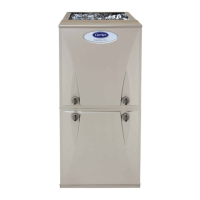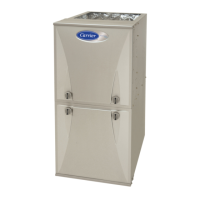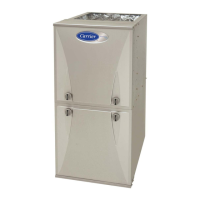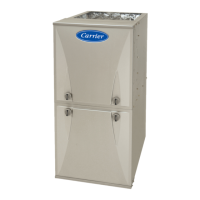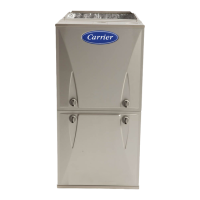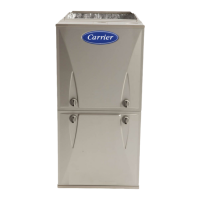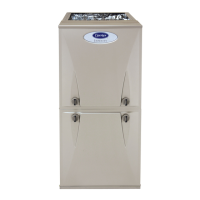ii
lection at blower-OFF delay switches). The furnace con-
trol CPU is factory-set for a 120-sec blower-OFF delay.
2. Two-Stage Thermostat and Two-Stage Heating
See Fig. 35 and 36 for thermostat connections.
NOTE: In this mode the low-heat only switch SWI-2 must be
ON to select the low-heat only operation mode in response to
closing the thermostat R-to-Wl circuit. Closing the thermostat
R-to- Wl-and-W2 circuits always causes high-heat operation,
regardless of the setting of the low-heat only switch.
The wall thermostat "calls for heat", closing the R-to-Wl circuit
for low-heat or closing the R-to-Wl-and-W2 circuits for
high-heat. The furnace control performs a self-check, verifies the
low-heat and high-heat pressure switch contacts LPS and HPS are
open, and starts the inducer motor IDM in high-speed.
The start up and shut down functions and delays described in item
1. above apply to the 2-stage heating mode as well, except for
switching from low- to high-Heat and vice versa.
a. Switching from Low- to High-Heat - If the thermostat
R-to-W1 circuit is closed and the R-to-W2 circuit closes,
the furnace control CPU will switch the inducer motor
IDM speed from low to high. The high-heat pressure
switch relay HPSR is de-energized to close the NC contact.
When sufficient pressure is available the high-heat pres-
sure switch HPS closes, and the high-heat gas valve solen-
oid GV-HI is energized. The blower motor BLWM will
transition to high-heat airflow five sec after the R-to-W2
circuit closes.
b. Switching from High- to Low-Heat -If the thermostat
R-to- W2 circuit opens, and the R-to-W1 circuit remains
closed, the furnace control CPU will switch the inducer
motor IDM speed from high to low. The high-heat pres-
sure switch relay HPSR is energized to open the NC contact
and de-energize the high-heat gas valve solenoid GV-HI.
When the inducer motor IDM reduces pressure suffi-
ciently, the high-heat pressure switch HPS will open. The
gas valve solenoid GV-M will remain energized as long
as the low-heat pressure switch LPS remains closed. The
blower motor BLWM will transition to low-heat airflow
five sec after the R-to-W2 circuit opens.
3. Cooling mode
The thermostat "calls for cooling".
a. Single-Speed Cooling-
See Fig. 35 and 36 for thermostat connections
The thermostat closes the R-to-G-and-Y circuits. The
R-to- Y circuit starts the outdoor unit, and the R-to-
G-and-Y/Y2 circuits start the furnace blower motor
BLWM on cooling airflow. Cooling airflow is based on the
A/C selection shown in Fig. 55. The electronic air cleaner
terminal EAC-I is energized with 115 vac when the
blower motor BLWM is operating.
When the thermostat is satisfied, the R-to-G-and-Y cir-
cuits are opened. The outdoor unit will stop, and the fur-
nace blower motor BLWM will continue operating at cool-
ing airflow for an additional 90 sec. Jumper Y/Y2 to
DHUM to reduce the cooling off-delay to 5 sec. (See Fig.
35.)
b. Single-Stage Thermostat and Two-Speed Cooling
(Adaptive Mode) -
See Fig. 35 and 36 for thermostat connections.
This furnace can operate a two-speed cooling unit with a
single-stage thermostat because the furnace control CPU
includes a programmed adaptive sequence of controlled
operation, which selects low-cooling or high-cooling op-
eration. This selection is based upon the stored history of
the length of previous cooling period of the single-stage
thermostat.
NOTE: The air conditioning relay disable jumper ACRDJ must
be connected to enable the adaptive cooling mode in response to a
call for cooling. (See Fig. 35.) When ACRDJ is in place the
furnace control CPU can turn on the air conditioning relay ACR to
energize the Y/Y2 terminal and switch the outdoor unit to
high-cooling.
The furnace control CPU can start up the cooling unit in either
low- or high-cooling. If starting up in low-cooling, the furnace
control CPU determines the low-cooling on-time (from 0 to 20
minutes) which is permitted before switching to high-cooling. If
the power is interrupted, the stored history is erased and the furnace
control CPU will select low-cooling for up to 20 minutes and then
energize the air conditioning relay ACR to energize the Y/Y2
terminal and switch the outdoor unit to high-cooling, as long as
the thermostat continues to call for cooling. Subsequent selection is
based on stored history of the thermostat cycle times.
The wall thermostat "calls for cooling", closing the
R-to-G-and-Y circuits. The R-to-Yl circuit starts the outdoor
unit on low-cooling speed, and the R-to-G-and-Yl circuits starts
the furnace blower motor BLWM at low-cooling airflow which is
the true on-board CF selection as shown in Fig. 35.
If the furnace control CPU switches from low-cooling to
high-cooling, the furnace control CPU will energize the air
conditioning relay ACR. When the air conditioning relay ACR is
energized the R-to-Yl-and-Y2 circuits switch the outdoor unit to
high-cooling speed, and the R-to-G-and-Yl-and-Y/Y2 circuits
transition the furnace blower motor BLWM to high-cooling
airflow. High-cooling airflow is based on the A/C selection shown
in Fig. 35.
NOTE: When transitioning from low-cooling to high-cooling the
outdoor unit compressor will shut down for 1 minute while the
furnace blower motor BLWM transitions to run at high-cooling
airflow.
The electronic air cleaner terminal EAC-1 is energized with 115
vac whenever the blower motor BLWM is operating.
When the thermostat is satisfied, the R-to-G-and-Y circuit are
opened. The outdoor unit stops, and the furnace blower BLWM
and electronic air cleaner terminal EAC-1 will remain energized
for an additional 90 sec. Jumper Y1 to DHUM to reduce the
cooling off-delay to 5 sec. (See Fig. 35.)
c. Two-Stage Thermostat and Two-Speed Cooling
See Fig. 35 and 36 for thermostat connections
NOTE: The air conditioning relay disable jumper ACRDJ must
be disconnected to allow thermostat control of the outdoor unit
staging. (See Fig. 350
The thermostat closes the R-to-G-and-Y1 circuits for
low-cooling or doses the R-to-G-and-Yl-and-Y2 circuits for
high-cooling. The R-to-Y1 circuit starts the outdoor unit on
low-cooling speed, and the R-to-G-and-Y1 circuit starts the
furnace blower motor BLWM at low-cooling airflow which is the
true on-board CF (continuous fan) selection as shown in Fig. 56.
The R-to-Yl-and-Y2 circuits start the outdoor unit on
high-cooling speed, and the R-to- G-and-Y/Y2 circuits start the
furnace blower motor BLWM at high-cooling airflow.
High-cooling airflow is based on the A/C (air conditioning)
selection shown in Fig. 55.
The electronic air cleaner terminal EAC-1 is energized with 115
vac whenever the blower motor BLWM is operating.
When the thermostat is satisfied, the R-to-G-and-Y1 or R-to-
G-and-Yl-and-Y2 circuits are opened. The outdoor unit stops,
and the furnace blower BLWM and electronic air cleaner terminal
EAC-1 will remain energized for an additional 90 sec. Jumper Y1
to DHUM to reduce the cooling off-delay to 5 sec. (See Fig. 35.)
4. Dehumidification Mode
See Fig. 35 and 36 for thermostat connections.
The dehumidification output, D or DHUM on the Thermo-
82

